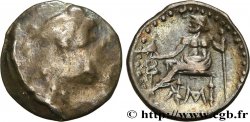bga_221955 - DANUBIAN CELTS - IMITATIONS OF THE TETRADRACHMS OF ALEXANDER III AND HIS SUCCESSORS Tétradrachme, imitation du type de Philippe III
180.00 €(Approx. 203.40$ | 154.80£)
Quantity
Add to your cart

Type : Tétradrachme, imitation du type de Philippe III
Date: c. IIe siècle AC.
Metal : silver
Diameter : 27,5 mm
Orientation dies : 12 h.
Weight : 14,96 g.
Rarity : R1
Coments on the condition:
Flan très large avec un portrait identifiable et un revers pas encore trop dégénéré. Frappe molle ou coins usés. Patine grise
Catalogue references :
Predigree :
Cet exemplaire est le n° 1626 de MONNAIES 41
Obverse
Obverse legend : ANÉPIGRAPHE.
Obverse description : Restes de la tête imberbe d’Héraklès à droite, coiffé de la léonté.
Reverse
Reverse legend : LÉGENDE ILLISIBLE.
Reverse description : Zeus assis à gauche, tenant un aigle de la main droite et un sceptre long de la main gauche ; monogramme dans le champ à gauche et sous le trône.
Commentary
Ces monnaies dégénèrent jusqu’à ce que le droit ne soit plus du tout identifiable, laissant la place à une masse en relief, sans aucun motif.








 Report a mistake
Report a mistake Print the page
Print the page Share my selection
Share my selection Ask a question
Ask a question Consign / sell
Consign / sell
 Full data
Full data









